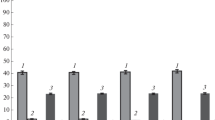Summary
Zymomonas mobilis UQM 2716 was grown anaerobically in continuous culture (D = 0.1/h; 30° C) 3nder glucose or nitrogen limitation at pH 6.5 or 4.0. The rates of glucose consumption and ethanol production were lowest during glucose-limited growth at pH 6.5, but increased during growth at pH 4.0 or under nitrogen limitation, and were highest during nitrogen-limited growth at pH 4.0. The uncoupling agent CCCP substantially increased the rate of glucose consumption by glucose-limited cultures at pH 6.5, but had much less effect at pH 4.0. Washed cells also metabolised glucose rapidly, irrespective of the conditions under which the original cultures were grown, and the rates were variably increased by low pH and CCCP. Broken cells exhibited substantial ATPase activity, which was increased by growth at low pH. It was concluded that the fermentation rates of cultures growing under glucose or nitrogen limitation at pH 6.5, or under glucose limitation at pH 4.0, are determined by the rate at which energy is dissipated by various cellular activities (including growth, ATP-dependent proton extrusion for maintenance of the protonmotive force and the intracellular pH, and an essentially constitutive ATP-wasting reaction that only operates in the presence of excess glucose). During growth under nitrogen limitation at pH 4.0 the rate of energy dissipation is sufficiently high for the fermentation rate to be determined by the inherent catalytic activity of the catabolic pathway.
Similar content being viewed by others
Abbreviations
- CCCP:
-
carbonyl cyanide p-trifluoromethoxyphenylhydrazone
- qG:
-
rate of glucose consumption (g glucose/g dry wt cells/h)
- qE:
-
rate of ethanol production (g ethanol/g dry wt cells/h)
- Y:
-
growth yield (g dry wt cells/g glucose)
- D:
-
dilution rate
References
Barrow KD, Collins JG, Norton RS, Rogers PL, Smith GH (1985) 31P nuclear magnetic resonance studies of the fermentation of glucose to ethanol by Zymomonas mobilis. J Biol Chem 259:5711–5716
Beardsmore AJ, Aperghis PNG, Quayle JR (1982) Characterisation of the assimilatory and dissimilatory pathways of carbon metabolism during growth of Methylophilus methylotrophus on methanol. J Gen Microbiol 128:1423–1439
Bergmeyer HU (ed) (1974) Methods of enzymatic analysis, vol 1, 2nd edn. Academic Press, New York
Cornish A, Greenwood JA, Jones CW (1988) The relationship between glucose transport and the production of succinoglucan exopolysaccharide by Agrobacterium radiobacter. J Gen Microbiol 134:3111–3122
Dawson MJ, Jones CW (1982) The protonmotive force and phosphorylation potential developed by whole cells of the methylotrophic bacterium Methylophilus methylotrophus. Arch Microbiol 133:55–61
Dimarco AA, Romano AH (1985) d-Glucose transport system of Zymomonas mobilis. Appl Environ Microbiol 49:151–157
Doelle HW, Doelle MB (1989) Zymomonas ethanol technology. Aust J Biotechnol 3:218–223
Harold FM (1986) The vital force — a study of bioenergetics. Freeman, New York
Kalnenieks UZ, Pankova LM, Shvinka YE (1987) Protonmotive force in the bacterium Zymomonas mobilis. Mikrobiologiya 52:721–723
Lawford HG (1988) A new approach to improving the performance of Zymomonas in continuous ethanol fermentations. Appl Biochem Biotechnol 17:203–209
Lawford HG, Stevnsborg N (1986) Comparative performance testing of nutritionally generated phenotypic variants of different strains of Zymomonas mobilis in continuous ethanol fermentations. Biotechnol Bioeng Symp 17:209–219
Lawford HG, Holloway P, Ruggiero A (1988) Effect of pH on growth and ethanol production by Zymomonas. Biotechnol Lett 10:809–814
Linton JD (1990) The relationship between metabolite production and the growth efficiency of the producing organism. FEMS Microbiol Rev 75:1–18
Linton JD, Rye AJ (1989) The relationship between the energetic efficiency in different microorganisms and the rate and type of metabolite overproduced. J Ind Microbiol 4:85–96
Millar DG, Griffiths-Smith K, Algar E, Scopes RK (1982) Activity and stability of glycolytic enzymes in the presence of ethanol. Biotechnol Lett 4:601–606
Osman YA, Ingram LO (1985) Mechanism of ethanol inhibition of fermentation in Zymomonas mobilis CP4. J Bacteriol 164:173–180
Osman YA, Conway T, Bonetti SJ, Ingram LO (1987) Glycolytic flux in Zymomonas mobilis: enzyme and metabolite levels during batch fermentation. J Bacteriol 169:3726–3736
Tempest DW, Neijssel OM (1984) The status of Y ATP and maintenance energy as biologically intepretable phenomena. Annu Rev Microbiol 38:459–486
Viikari L (1988) Carbohydrate metabolism in Zymomonas. CRC Crit Rev Biotechnol 7:237–261
Author information
Authors and Affiliations
Additional information
Offprint requests to: C. W. Jones
Rights and permissions
About this article
Cite this article
Jones, C.W., Doelle, H.W. Kinetic control of ethanol production by Zymomonas mobilis . Appl Microbiol Biotechnol 35, 4–9 (1991). https://doi.org/10.1007/BF00180626
Received:
Accepted:
Issue Date:
DOI: https://doi.org/10.1007/BF00180626




